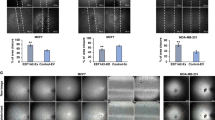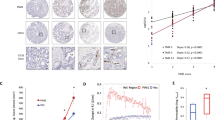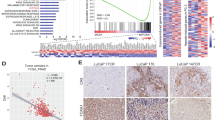Abstract
Transforming growth factor (TGF)-β1 has biphasic functions in prostate tumorigenesis, having a growth-inhibitory effect in the early stages, but in the late stages promoting tumor angiogenesis and metastasis. We demonstrate here that tumor-producing TGF-β1 induces vascular endothelial growth factor (VEGF) in prostate cancer cells, and hypoxia-inducible factor (HIF)-1α and HIF-2α has opposite functions in TGF-β1 regulation of VEGF expression under non-hypoxic conditions. The promoter response of VEGF to TGF-β1 was upregulated by the transfection of HIF-2α or siHIF-1α but downregulated by HIF-1α and siHIF-2α. Both HIF-1α and HIF-2α were induced by TGF-β1 at mRNA and protein levels, however, their nuclear translocation was differentially regulated by TGF-β1, suggesting its association with their opposite effects. VEGF induction by TGF-β1 occurred in a Smad3-dependent manner, and the Smad-binding element 2 (SBE2, −992 to −986) and hypoxia response element (−975 to −968) in the VEGF promoter were required for the promoter response to TGF-β1. Smad3 cooperated with HIF-2α in TGF-β1 activation of VEGF transcription and Smad3 binding to the SBE2 site was greatly impaired by knockdown of HIF-2α expression. Moreover, the VEGF promoter response to TGF-β1 was synergistically elevated by co-transfection of Smad3 and HIF-2α but attenuated by HIF-1α in a dose-dependent manner. Additionally, TGF-β1 was found to increase the stability of VEGF transcript by facilitating the cytoplasmic translocation of a RNA-stabilizing factor HuR. Collectively, our data show that tumor-producing TGF-β1 induces VEGF at the both transcription and post-transcriptional levels through multiple routes including Smad3, HIF-2α and HuR. This study thus suggests that autocrine TGF-β1 production may contribute to tumor angiogenesis via HIF-2α signaling under non-hypoxic conditions, providing a selective growth advantage for prostate tumor cells.
This is a preview of subscription content, access via your institution
Access options
Subscribe to this journal
Receive 50 print issues and online access
$259.00 per year
only $5.18 per issue
Buy this article
- Purchase on Springer Link
- Instant access to full article PDF
Prices may be subject to local taxes which are calculated during checkout







Similar content being viewed by others
Abbreviations
- TGF-β1:
-
transforming growth factor-β1
- VEGF:
-
vascular endothelial growth factor
- HIF:
-
hypoxia-inducible factor
- NF-κB:
-
nuclear factor-κB
- PI3K:
-
phosphoinositide-3-kinase
- RT–PCR:
-
reverse transcription–PCR
- siRNA:
-
short-interfering RNA
References
Benjamin D, Moroni C . (2007). mRNA stability and cancer: an emerging link? Expert Opin Biol Ther 7: 1515–1529.
Benckert C, Jonas S, Cramer T, Von Marschall Z, Schäfer G, Peters M et al. (2003). Transforming growth factor β1 stimulates vascular endothelial growth factor gene transcription in human cholangiocellular carcinoma cells. Cancer Res 63: 1083–1092.
Blancher C, Moore JW, Talks KL, Houlbrook S, Harris AL . (2000). Relationship of hypoxia-inducible factor (HIF)-1α and HIF-2α expression to vascular endothelial growth factor induction and hypoxia survival in human breast cancer cell lines. Cancer Res 60: 7106–7113.
Boddy JL, Fox SB, Han C, Campo L, Turley H, Kanga S et al. (2005). The androgen receptor is significantly associated with vascular endothelial growth factor and hypoxia sensing via hypoxia-inducible factors HIF-1α, HIF-2α, and the prolyl hydroxylases in human prostate cancer. Clin Cancer Res 11: 7658–7663.
Brown JM, Wilson WR . (2004). Exploiting tumour hypoxia in cancer treatment. Nat Rev Cancer 4: 437–447.
Derynck R, Zhang YE . (2003). Smad-dependent and Smad-independent pathways in TGF-β family signaling. Nature 425: 577–584.
Dixon DA, Tolley ND, King PH, Nabors LB, McIntyre TM, Zimmerman GA et al. (2001). Altered expression of the mRNA stability factor HuR promotes cyclooxygenase-2 expression in colon cancer cells. J Clin Invest 108: 1657–1665.
Fan XC, Steitz JA . (1998). HNS, a nuclear-cytoplasmic shuttling sequence in HuR. Proc Natl Acad Sci USA 95: 15293–15298.
Ferrara N . (2004). Vascular endothelial growth factor: basic science and clinical progress. Endocr Rev 25: 581–611.
Fukuda R, Kelly B, Semenza GL . (2003). Vascular endothelial growth factor gene expression in colon cancer cells exposed to prostaglandin E2 is mediated by hypoxia-inducible factor 1. Cancer Res 63: 2330–2334.
Jackson MW, Roberts JS, Heckford SE, Ricciardelli C, Stahl J, Choong C et al. (2002). A potential autocrine role for vascular endothelial growth factor in prostate cancer. Cancer Res 62: 854–859.
Jeon SH, Chae BC, Kim HA, Seo GY, Seo DW, Chun GT et al. (2007). Mechanisms underlying TGF-β1-induced expression of VEGF and Flk-1 in mouse macrophages and their implications for angiogenesis. J Leukoc Biol 81: 557–566.
Helczynska K, Larsson AM, Holmquist Mengelbier L, Bridges E, Fredlund E, Borgquist S et al. (2008). Hypoxia-inducible factor-2α correlates to distant recurrence and poor outcome in invasive breast cancer. Cancer Res 68: 9212–9220.
Heldin CH, Miyazono K, ten Dijke P . (1997). TGF-β signalling from cell membrane to nucleus through SMAD proteins. Nature 390: 465–471.
Holmquist-Mengelbier L, Fredlund E, Löfstedt T, Noguera R, Navarro S, Nilsson H et al. (2006). Recruitment of HIF-1α and HIF-2α to common target genes is differentially regulated in neuroblastoma: HIF-2α promotes an aggressive phenotype. Cancer Cell 10: 413–423.
Giatromanolaki A, Sivridis E, Kouskoukis C, Gatter KC, Harris AL, Koukourakis MI . (2003). Hypoxia-inducible factors 1α and 2α are related to vascular endothelial growth factor expression and a poorer prognosis in nodular malignant melanomas of the skin. Melanoma Res 13: 493–501.
Goodyear SM, Kheyfets SB, Garcia FU, Stearns ME . (2009). Role of the VEGFR3/VEGFD receptor axis in TGFβ1 activation of primary prostate cell lines. Prostate 69: 982–990.
Kang MJ, Ryu BK, Lee MG, Han J, Lee JH, Ha TK et al. (2008). NF-κB activates transcription of the RNA-binding factor HuR, via PI3K-AKT signaling, to promote gastric tumorigenesis. Gastroenterology 135: 2030–2042.
Kim IY, Ahn HJ, Zelner DJ, Shaw JW, Lang S, Kato M et al. (1996). Loss of expression of transforming growth factor β type I and type II receptors correlates with tumor grade in human prostate cancer tissues. Clin Cancer Res 2: 1255–1261.
Kondo K, Klco J, Nakamura E, Lechpammer M, Kaelin Jr WG . (2002). Inhibition of HIF is necessary for tumor suppression by the von Hippel-Lindau protein. Cancer Cell 1: 237–246.
Laughner E, Taghavi P, Chiles K, Mahon PC, Semenza GL . (2001). HER2 (neu) signaling increases the rate of hypoxia-inducible factor 1α (HIF-1α) synthesis: novel mechanism for HIF-1-mediated vascular endothelial growth factor expression. Mol Cell Biol 21: 3995–4004.
Löfstedt T, Fredlund E, Holmquist-Mengelbier L, Pietras A, Ovenberger M, Poellinger L et al. (2007). Hypoxia inducible factor-2α in cancer. Cell Cycle 6: 919–926.
Loureiro RM, D'Amore PA . (2005). Transcriptional regulation of vascular endothelial growth factor in cancer. Cytokine Growth Factor Rev 16: 77–89.
Lu S, Lee J, Revelo M, Wang X, Lu S, Dong Z . (2007). Smad3 is overexpressed in advanced human prostate cancer and necessary for progressive growth of prostate cancer cells in nude mice. Clin Cancer Res 13: 5692–5702.
Maranchie JK, Vasselli JR, Riss J, Bonifacino JS, Linehan WM, Klausner RD . (2002). The contribution of VHL substrate binding and HIF1-α to the phenotype of VHL loss in renal cell carcinoma. Cancer Cell 1: 247–255.
Massague J . (1990). The transforming growth factor-β family. Ann Rev Cell Biol 6: 597–641.
McMahon S, Charbonneau M, Grandmont S, Richard DE, Dubois CM . (2006). Transforming growth factor β1 induces hypoxia-inducible factor-1 stabilization through selective inhibition of PHD2 expression. J Biol Chem 281: 24171–24181.
Mukhopadhyay D, Tsiokas L, Zhou XM, Foster D, Brugge JS, Sukhatme VP . (1995). Hypoxic induction of human vascular endothelial growth factor expression through c-Src activation. Nature 375: 577–581.
Nabors LB, Gillespie GY, Harkins L, King PH . (2001). HuR, a RNA stability factor, is expressed in malignant brain tumors and binds to adenine- and uridine-rich elements within the 3′ untranslated regions of cytokine and angiogenic factor mRNAs. Cancer Res 61: 2154–2161.
Noguera R, Fredlund E, Piqueras M, Pietras A, Beckman S, Navarro S et al. (2009). HIF-1α and HIF-2α are differentially regulated in vivo in neuroblastoma: high HIF-1α correlates negatively to advanced clinical stage and tumor vascularization. Clin Cancer Res 15: 7130–7136.
Pallares J, Rojo F, Iriarte J, Morote J, Armadans LI, de Torres I . (2006). Study of microvessel density and the expression of the angiogenic factors VEGF, bFGF and the receptors Flt-1 and FLK-1 in benign, premalignant and malignant prostate tissues. Histol Histopathol 21: 857–865.
Park BJ, Park JI, Byun DS, Park JH, Chi SG . (2000). Mitogenic conversion of transforming growth factor-β1 effect by oncogenic Ha-Ras-induced activation of the mitogen-activated protein kinase signaling pathway in human prostate cancer. Cancer Res 60: 3031–3038.
Park JI, Lee MG, Cho K, Park BJ, Chae KS, Byun DS et al. (2003). Transforming growth factor-β1 activates interleukin-6 expression in prostate cancer cells through the synergistic collaboration of the Smad2, p38-NF-κB, JNK, and Ras signaling pathways. Oncogene 22: 4314–4332.
Pietras A, Gisselsson D, Ora I, Noguera R, Beckman S, Navarro S et al. (2008). High levels of HIF-2α highlight an immature neural crest-like neuroblastoma cell cohort located in a perivascular niche. J Pathol 214: 482–488.
Pu H, Collazo J, Jones E, Gayheart D, Sakamoto S, Vogt A et al. (2009). Dysfunctional transforming growth factor-β receptor II accelerates prostate tumorigenesis in the TRAMP mouse model. Cancer Res 69: 7366–7374.
Raval RR, Lau KW, Tran MG, Sowter HM, Mandriota SJ, Li JL et al. (2005). Contrasting properties of hypoxia-inducible factor 1 (HIF-1) and HIF-2 in von Hippel-Lindau-associated renal cell carcinoma. Mol Cell Biol 25: 5675–5686.
Ryan HE, Lo J, Johnson RS . (1998). HIF-1α is required for solid tumor formation and embryonic vascularization. EMBO J 17: 3005–3015.
Sanchez-Elsner T, Botella LM, Velasco B, Corbi A, Attisano L, Bernabeu C . (2001). Synergistic cooperation between hypoxia and transforming growth factor-β pathways on human vascular endothelial growth factor gene expression. J Biol Chem 276: 38527–38535.
Semenza GL . (1998). Hypoxia-inducible factor 1: master regulator of O2 homeostasis. Curr Opin Genet Dev 8: 588–594.
Semenza GL . (2003). Targeting HIF-1 for cancer therapy. Nat Rev Cancer 3: 721–732.
Shi Y, Massague J . (2003). Mechanisms of TGF-β signaling from cell membrane to the nucleus. Cell 113: 685–700.
Stearns ME, Garcia FU, Fudge K, Rhim J, Wang M . (1999). Role of interleukin 10 and transforming growth factor β1 in the angiogenesis and metastasis of human prostate primary tumor lines from orthotopic implants in severe combined immunodeficiency mice. Clin Cancer Res 5: 711–720.
Sugano Y, Matsuzaki K, Tahashi Y, Furukawa F, Mori S, Yamagata H et al. (2003). Distortion of autocrine transforming growth factor β signal accelerates malignant potential by enhancing cell growth as well as PAI-1 and VEGF production in human hepatocellular carcinoma cells. Oncogene 22: 2309–2321.
Tran H, Maurer F, Nagamine Y . (2003). Stabilization of urokinase and urokinase receptor mRNAs by HuR is linked to its cytoplasmic accumulation induced by activated mitogen-activated protein kinase-activated protein kinase 2. Mol Cell Biol 23: 7177–7188.
Truong LD, Kadmon D, McCune BK, Flanders KC, Scardino PT, Thompson TC . (1993). Association of transforming growth factor-β1 with prostate cancer: an immunohistochemical study. Human Pathology 24: 4–9.
Uchida T, Rossignol F, Matthay MA, Mounier R, Couette S, Clottes E et al. (2004). Prolonged hypoxia differentially regulates hypoxia-inducible factor (HIF)-1α and HIF-2α expression in lung epithelial cells: implication of natural antisense HIF-1α. J Biol Chem 279: 14871–14878.
Wang GL, Jiang BH, Rue EA, Semenza GL . (1995). Hypoxia-inducible factor 1 is a basic-helix-loop-helix-PAS heterodimer regulated by cellular O2 tension. Proc Natl Acad Sci USA 92: 5510–5551.
Wang L, Kwak JH, Kim SI, He Y, Choi ME . (2004). Transforming growth factor-β1 stimulates vascular endothelial growth factor 164 via mitogen-activated protein kinase 3-p38α and p38δ mitogen-activated protein kinase-dependent pathway in murine mesangial cells. J Biol Chem. 279: 33213–33219.
Wang W, Caldwell MC, Lin S, Furneaux H, Gorospe M . (2000). HuR regulates cyclin A and cyclin B1 mRNA stability during cell proliferation. EMBO J 19: 2340–2350.
Wang W, Yang X, Cristofalo VJ, Holbrook NJ, Gorospe M . (2001). Loss of HuR is linked to reduced expression of proliferative genes during replicative senescence. Mol Cell Biol 21: 5889–5898.
Williams RH, Stapleton AM, Yang G, Truong LD, Rogers E, Timme TL et al. (1996). Reduced levels of transforming growth factor β receptor type II in human prostate cancer: an immunohistochemical study. Clin Cancer Res 2: 635–640.
Yoshimura H, Dhar DK, Kohno H, Kubota H, Fujii T, Ueda S et al. (2004). Prognostic impact of hypoxia-inducible factors 1α and 2α in colorectal cancer patients: correlation with tumor angiogenesis and cyclooxygenase-2 expression. Clin Cancer Res 10: 8554–8560.
Zhong H, Chiles K, Feldser D, Laughner E, Hanrahan C, Georgescu MM et al. (2000). Modulation of hypoxia-inducible factor 1α expression by the epidermal growth factor/phosphatidylinositol 3-kinase/PTEN/AKT/FRAP pathway in human prostate cancer cells: implications for tumor angiogenesis and therapeutics. Cancer Res 60: 1541–1545.
Zhong H, Semenza GL, Simons JW, De Marzo AM . (2004). Up-regulation of hypoxia-inducible factor 1α is an early event in prostate carcinogenesis. Cancer Detect Prev 28: 88–93.
Zhu B, Kyprianou N . (2005). Transforming growth factor β and prostate cancer. Cancer Treat Res 126: 157–173.
Acknowledgements
This work was supported in part by grants from National Research Foundation of Korea (0000794 and 0001197), the Korea Research Foundation (2008-314-C00247) and the National Cancer Center (0820070), Republic of Korea.
Author information
Authors and Affiliations
Corresponding author
Ethics declarations
Competing interests
The authors declare no conflict of interest.
Additional information
Disclaimer
All of the authors are aware of and agree to the content of the paper and their being listed as authors on the paper. This manuscript does not contain any information conveyed either by personal communication or release of unpublished experimental data.
Rights and permissions
About this article
Cite this article
Chae, K., Kang, M., Lee, J. et al. Opposite functions of HIF-α isoforms in VEGF induction by TGF-β1 under non-hypoxic conditions. Oncogene 30, 1213–1228 (2011). https://doi.org/10.1038/onc.2010.498
Received:
Revised:
Accepted:
Published:
Issue Date:
DOI: https://doi.org/10.1038/onc.2010.498
Keywords
This article is cited by
-
Mechanisms of HIF-driven immunosuppression in tumour microenvironment
Journal of the Egyptian National Cancer Institute (2023)
-
Hypoxia-induced signaling in the cardiovascular system: pathogenesis and therapeutic targets
Signal Transduction and Targeted Therapy (2023)
-
LINC00152 induced by TGF-β promotes metastasis via HuR in lung adenocarcinoma
Cell Death & Disease (2022)
-
PHD2 attenuates high-glucose-induced blood retinal barrier breakdown in human retinal microvascular endothelial cells by regulating the Hif-1α/VEGF pathway
Inflammation Research (2022)
-
Multiple functions of HuR in urinary tumors
Journal of Cancer Research and Clinical Oncology (2019)



